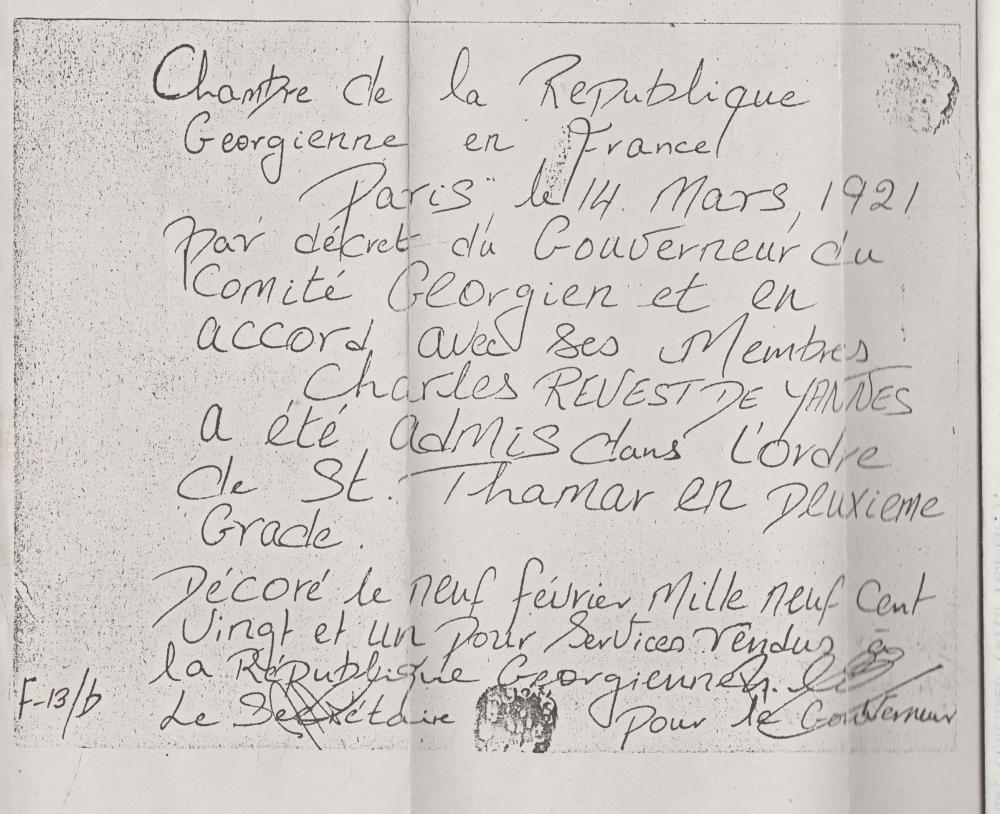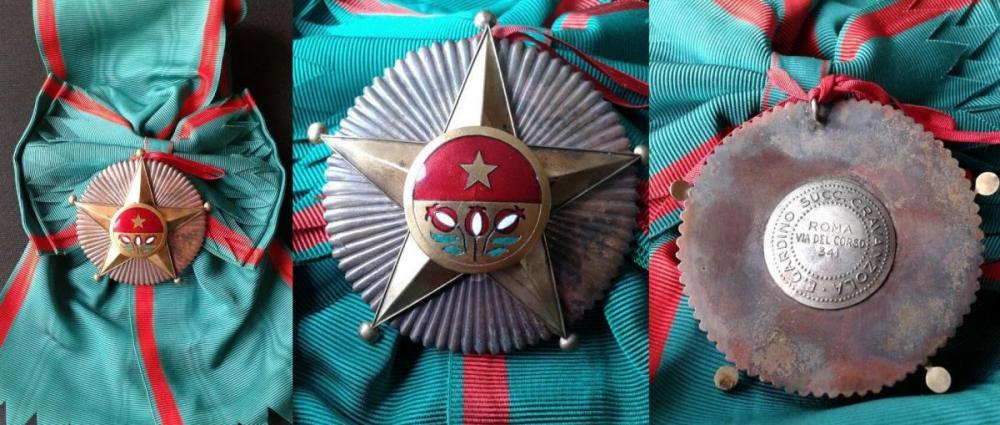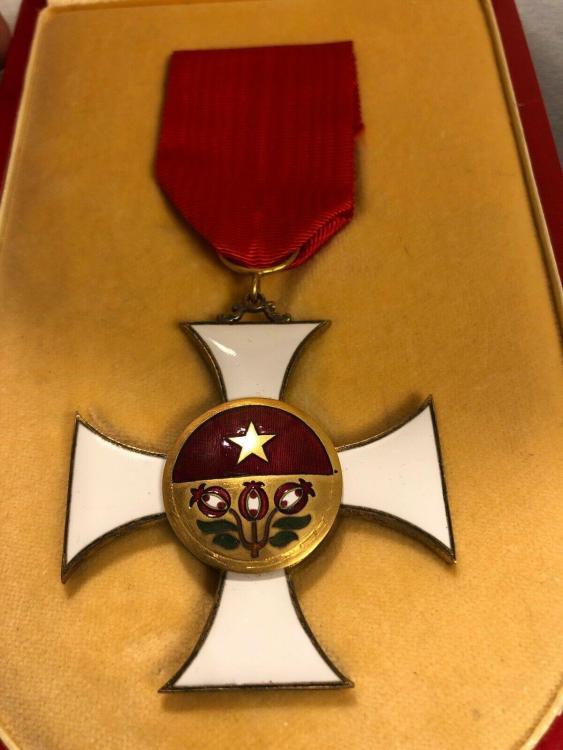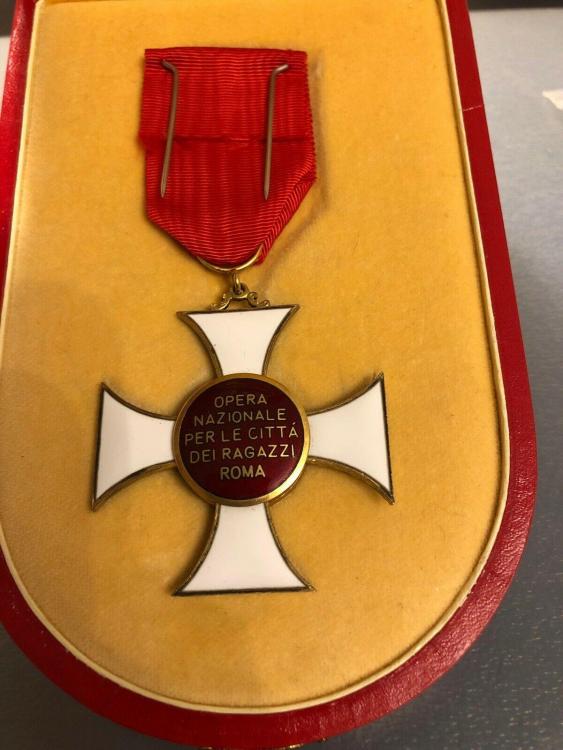
922F
Patron-
Posts
1,397 -
Joined
-
Last visited
-
Days Won
7
Content Type
Profiles
Forums
Blogs
Gallery
Events
Store
Everything posted by 922F
-
Thank you, Dr. Kolahdooz for these extremely valuable original documents and especially for your translations!!
-
Interesting photos medal awardees from The Netherlands
922F replied to OvBacon's topic in Northern European & Baltic States
Yes, please keep them coming! -
Lightening Strikes!!! For those interested in this thread--hold onto your hats!! A vendor seems to have gotten into Johnson's archive. The matrix for these medals just appeared on Italian evBay staring at a mere 100 euros! See: sc1-34) MATRICI PER MEDAGLIA GIOVANNI CARLO II ORDINE DEL LENTASIO ANNI 1930 Numero oggetto eBay: 223995816737 I'm certain that these cost considerably more to cut than the opening offer price...
-
Mannerheim Cross in wear
922F replied to BalkanCollector's topic in Northern European & Baltic States
Great topic--Thank you for posting!! -
Further to Arnaud's comment, at least two vendors offered examples of Order of Reconciliation insignia within the past 5 months for 40 -50 euros. These may have been 'overproduction' or have 'fallen off the delivery truck'.
-
Attached below find the document copy. As to Pat66‘s images, this type insignia did not appear on the market until 2014 at the earliest to my knowledge. I have studied this Order since 1970 and never saw such pieces until they were offered on German eBay. By 2016-7 they appeared on French and U.S. eBay. Rick Research, the guru of this award here on GMIC and elsewhere [some material links below], tracked down the originator. In one of his posts he exposes the chain of evidence. Unfortunately I could not find his specific post on the point at this time. Seem to recall that the pieces came out of Poland or Russia. The Bagration-Mukhraneli Royal House of Georgia website http://www.royalhouseofgeorgia.ge/p/eng/451/order-queen-tamar-order-history reports the following the regarding the Order: This award was made official by the Democratic Republic of Georgia in 1918 and recognized as an order of merit. The Order was abolished by the Communists, but its national significance was such that H.R.H. Prince Irakly – at the petition of the Union of Traditionalist Georgians – restored it and proclaimed himself Grand Master, with the consent of his father H.R.H. Giorgi XIII who was Head of the Royal House in 1942. Comment—Does this suggest a 1942 date for reactivating the Order? Rick Research spent years trying to verify this information in general and the date in particuliar. Efforts included discussions with various experts including Dr. Klietmann, contacting the Royal House and Georgian monarchist groups. Nowhere did he find evidence of this claim. It was then awarded to Georgians of the Diaspora and some members of the European royalty, among whom stand out the Head of the Imperial House of Russia HIH Grand Duke Wladimiro Kirilovich and the Head of the House of Borbón-Sevilla, Duke Francisco de Borbón y de Borbón, who was already an effective collaborator at the time. Comment---Rick Research attempted to verify HIH Grand Duke Wladimiro Kirilovich and Duke Francisco de Borbón y de Borbón as Order recipients, again without success. Efforts included contacts with both families and close scrutiny of 100s of images of these men. Rick could not find any information regarding awards to Georgians of the Diaspora, including among his Georgian monarchist informants. He did find much information regarding awards of the Order of the Sacred Tunic of Our Lord during the period in question. Upon the death of H.R.H. Prince Irakly [October 1977], his son H.R.H. Giorgi XIII did not want to make any more concessions from this Order for reasons of discretion, and it remained inactive. Given these historical precedents, recently H.R.H. Davit Bagrationi has resolved to reincorporate her fully into the Equestrian Heritage of the Royal House of Georgia, awarding it a new Constitutional Letter and conceding some appointments. Comment---Philip Eagleton, CEO of the insignia manufacturing firm WORTH, came into contact with H.R.H. Davit Bagrationi regarding the Order in 2007-9. A proposal to revive the Order occurred at that time. Eagleton prepared preliminary insignia sketches and commissioned an in depth research effort. In the end, WORTH lost the manufacturing agreement to Cejalvo. See http://www.condecoracionescejalvo.es/noble-decorations.html for images of their Tamara insignia, apparently based on Eagleton’s designs. Ref: http://www.royalhouseofgeorgia.ge/p/eng/451/order-queen-tamar-order-history http://www.omsa.org/files/jomsa_arch/Splits/1983/12099_JOMSA_Vol34_6_34.pdf Addenda to "Georgian Order of Saint Tamara Award. Document" https://www.omsa.org/files/download.php?file=JOMSA_Vol28_10.pdf&stream=true&year=1977 Georgian Order of Saint Tamara Award. Document Dr. K.G. Klietmann "Das ’Abzelchen’ und der ’Orden der Konigin Thamar’ in Georgien 1916 und 1918", Ordenskunde #23, 1964 I would be remiss to omit mention of the Republic of Georgia’s state honor The Order of Queen Tamara (თამარ მეფის ორდენი). A decree of the Parliament of Georgia № 1553 dated July 31, established the award. The Order may be conferred ONLY on females for outstanding services to the people and the homeland. The Order of Queen Tamara is awarded with a cash prize of 4,000 lari. https://www.president.gov.ge/geo/saqartvelo/sakhelmcifo-jildoebi.aspx I hope that this presentation proves useful. If anyone has any information or images relating to alleged 1942-1977 Tamara Order usage or bestowals please share them. I would welcome any evidence that the insignia type Pat66 illustrates dates before 2014. That type has been seen with dark blue and light blue soft enamel color centers, two different sorts of star rays and two different type reverse pins.
-
Welcome Georgia on my Mind! And Pat66 as well! Have you seen threads, The World's Most BIZARRE Award-- A New Chapter!, GEORGIAN ORDER OF QUEEN TAMARA BREAST STAR 3RD CLASS, My First Tamara, Tamara Resurgent, and many others? If not, just enter Tamara into GMIC's search engine. Rick Research sent me a photocopy of a Tamara document issued in Paris by an exile committee hand written on a half-sheet of paper. If you cannot find that image here in an existing thread, I could share a copy of the copy. Bryansk1959 beat me to the punch! Pat66's image illustrates one of the complete fake Tamaras that first appeared within the past few years. To my knowledge, these first showed up on German eBay and exist in two major varieties [depending on type of star rays and pins]. Cigarette cases bearing this type center have been making the rounds too. Seems there are 2 more or less well known claimants to the Georgia throne, each with 3 Orders at their disposal. Tamaras presented by Prince Davit, made by Cejalvo of Madrid, resemble Bryansk1959's images. Prince Nugzar does not seem to presently use an Order of Tamara. GMIC archives contain material on Prince Davit's awards, I don't know there’s information on Prince Nugzar's here but you can Goggle each by name and get full details..
-
Cuba Police Merit order - 1936 - 1959
922F replied to cuba1959's topic in Rest of the World: Militaria & History
Thank you for posting these rare and beautiful examples! -
An unidentified award image appears midway through the page 2 discussion of Burkino Faso awards [Posted May 29, 2014---topic link included]. The first image below depicts the item. This nearly 6 year old query may have found an answer via www.ebay.comitmItalian-Order-Medal-Opera-Nazionale-Per-LE-Citta-Dei-Ragazzi-Roma-Cased-Italy item 324112401347! The second and third figures below, the decoration bears a central medallion identical to the mystery object. The listing identified it as an award of the Opera Nazionale per le Città dei Ragazzi, a Rome based organization. Internet research established that the entity aims to provide assistance, social and professional education for children without valid family support and at risk of serious problems. I emailed the organization to learn if it uses an award to recognize financial and other contributions. The reply—maybe, sometimes. Unfortunately no further information was forthcoming. Presumably they have more emergent matters to hand now. In any case, we may now have an identification for a mystery medal!
-
Congratulations on assembling this group of rare decorations! Thank you for posting these images and information. The McKay collection at the Smithsonian Institution in Washington, D.C. U.S.A. contains a Grand Cross and a Grand Commander set of this Order. I saw them in the early 1970's; the Grand Cross star had an inscription on the reverse but I cannot recall whether it related to the maker or to an individual.
-
Thanks to all for contributions and work on this thread!
-
Thank you! I like your https://www.coleccionesmilitares.com/medallas/texto/mm03.htm work very much as you explain the 2003 changes! Antonio--Have you information about the Spanish corona virus cross decoration?
-
Great work Emmanuel -- any idea of manufacturer?
-
Excellent post, Patout; thank you for exposing the history of this remarkable soldier!
-
J. Swire reports the decoration in his article on Albanian awards in the Near East Yearbook; probably the 1931-32 edition. Artan Lame's Albanian Medals, Volume 1 cites establishment via Law of 14/05/1930 & Regulation of 24/11/1930. Lame writes that this was a project and doubts whether any examples or trial pieces exist. Filip Rrumullku's Dekorimet provides more detailed information, including establishment document images. In search of an image [project design or actual medal itself] of this item since 1966, I asked Swire and messrs Bertrand & Gardino [makers of Albanian awards in the 1930s] as well as other students without results. Mario Battstella, an Italian journalist and Skenderbeg Yilli holder, and Edith Durham [British champion of Albania] are the only people I've ever heard about as being possible recipients but I've not be able to verify either. [Durham's biographies do not mention such an award.] Never able to discover much about Battstella at all. Might say the same for the elusive or ephemeral Medal for Meritorious Service for the Royal Gendarmerie--Law of January 14, 1936. In that case, not even a suggestion of potential awardees!
-
Medal 'Benemerenti' Award Ceremony
922F replied to Antonio Prieto's topic in Southern European & Balkan States
Sincere thanks! Do you know where the insignia are manufactured? The overall format seems to have some elements in common with the [royal] BESA Order. -
Medal 'Benemerenti' Award Ceremony
922F replied to Antonio Prieto's topic in Southern European & Balkan States
Somehow just saw this post--Thank you Antonio. Any more information on this award? -
WONDERFUL!!
-
Yes, 1812, we all hope that you will remain healthy and happy! And for those sincerely interested in discovering an absolutely phantasmagorial Austro-Liberian link I highly recommend John Biggens' study Tomorrow the World: In which Cadet Otto Prohaska Carries the Habsburg Empire's Civilizing Mission to the Entirely Unreceptive Peoples of Africa and Oceania
-
Agree with Bayren--image shows Orders of Korea and Hawaii as well as Liberia. Even odder, I seem to recall a Crown of Steel of Araucania set on display there too.







